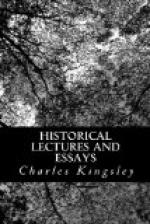England was to be conquered by the Norman; but by the civilised, not the barbaric; by the Norse who had settled, but four generations before, in the North East of France under Rou, Rollo, Rolf the Ganger—so-called, they say, because his legs were so long that, when on horseback, he touched the ground and seemed to gang, or walk. He and his Norsemen had taken their share of France, and called it Normandy to this day; and meanwhile, with that docility and adaptability which marks so often truly great spirits, they had changed their creed, their language, their habits, and had become, from heathen and murderous Berserkers, the most truly civilised people of Europe, and—as was most natural then—the most faithful allies and servants of the Pope of Rome. So greatly had they changed, and so fast, that William Duke of Normandy, the great-great-grandson of Rolf the wild Viking, was perhaps the finest gentleman, as well as the most cultivated sovereign, and the greatest statesman and warrior in all Europe.
So Harold of Norway came with all his Vikings to Stamford Bridge by York; and took, by coming, only that which Harold of England promised him, namely, “forasmuch as he was taller than any other man, seven feet of English ground.”
The story of that great battle, told with a few inaccuracies, but told as only great poets tell, you should read, if you have not read it already, in the “Heimskringla” of Snorri Sturluson, the Homer of the North:
High feast that day held the birds of the air and the beasts of the field, White-tailed erne and sallow glede, Dusky raven, with horny neb, And the gray deer the wolf of the wood.
The bones of the slain, men say, whitened the place for fifty years to come.
And remember, that on the same day on which that fight befell—September 27, 1066—William, Duke of Normandy, with all his French-speaking Norsemen, was sailing across the British Channel, under the protection of a banner consecrated by the Pope, to conquer that England which the Norse-speaking Normans could not conquer.




